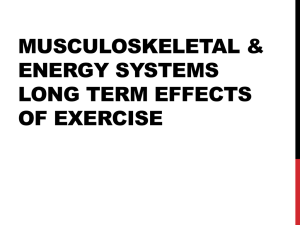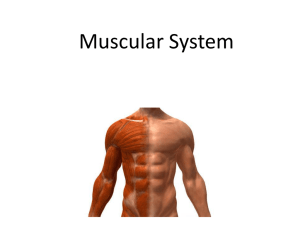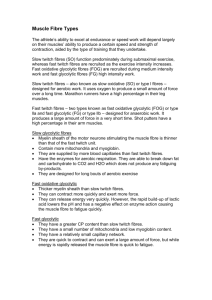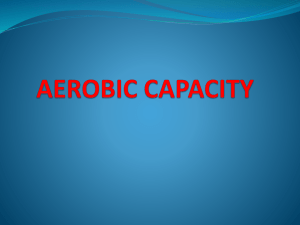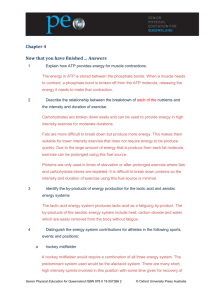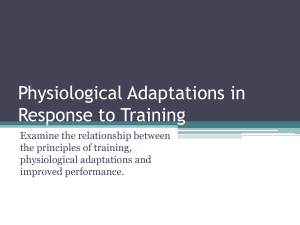Long term effects of exercise on Musculoskeletal system
advertisement
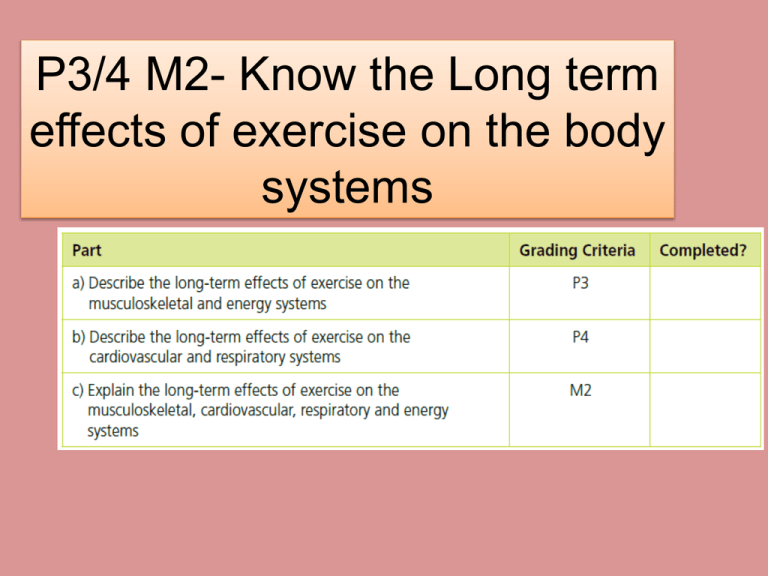
P3/4 M2- Know the Long term effects of exercise on the body systems • Cardiovascular system: cardiac hypertrophy; increase in stroke volume; increase in cardiac output, decrease in resting heart rate; capillarisation; increase in blood volume; reduction in resting blood pressure; decreased recovery time; increased aerobic fitness • Muscular system: hypertrophy; increase in tendon strength; increase in myoglobin stores; increased number of mitochondria; increased storage of glycogen and fat; increased muscle strength; increased tolerance to lactic acid • Skeletal system: increase in bone calcium stores; increased stretch in ligaments; increased thickness of hyaline cartilage; increased production of synovial fluid • Respiratory system: increased vital capacity; increase in minute ventilation; increased strength of respiratory muscles; increase in oxygen diffusion rate • Energy systems: increased aerobic and anaerobic enzymes; increased use of fats as an energy source Skeletal system: increase in bone calcium stores; increased stretch in ligaments; increased thickness of hyaline cartilage; increased production of synovial fluid Skeletal System • Increased mineral content – Basically your bones get stronger the more that you use them. – Exercise puts stress on the bones – This encourages the laying down of bony plates and calcium salts along the lines of stress – This increases the tensile strength of the bones – It also increases the strength of the supportive tissue around the joint (Tendons and Ligaments) • Exercise that increases bone strength: – Weight bearing exercise, such as tennis, football, running, basketball – Strength Training, such as Weight training, circuit training Skeletal System • Hyaline Cartilage – Becomes thicker with regular exercise – It is the most common type of cartilage in the body – It protects the bones from wear at the end of the joints – Provides shock absorption, such as between the vertebrae • Ligaments and Tendons • This means that there is more cushioning and shock absorption after regular exercise. – Both increase in flexibility with regular exercise. • This means stronger joints, and more powerful muscular contraction. Muscular responses to exercise Muscular system: hypertrophy; increase in tendon strength; increase in myoglobin stores; increased number of mitochondria; increased storage of glycogen and fat; increased muscle strength; increased tolerance to lactic acid Muscle cell • Aerobic exercise, for example a series of long runs, or cycle rides would cause changes to the structure of the muscle fibres – Specifically, slow twitch fibres would increase in size (Hypertrophy) • Perhaps up to 22% • This is due to the aerobic exercise putting stress on the slow twitch fibres (What type?) – Would give greater potential for aerobic energy production • (What effect would this have on the performance of footballers?) Mitochondria • Aerobic exercise has been seen to provide an increase in size and number of mitochondria – 40-100% • Mitochondria are the basis of our aerobic output – (What effect would this have on players performance in the scenario described in the task?) Oxidative enzymes • Oxidative Enzymes • It is suggested that Aerobic training increases the activity of oxidative enzymes – These break down food to release energy • So we would be able to produce more energy from our food • Couple this with the hypertrophy of our slow twitch muscles, and we can supply energy and perform for longer sustained periods – How would this benefit players? Myoglobin • Myoglobin is the substance within the muscle that carries Oxygen to the Mitochondria – Aerobic training can increase myoglobin content by up to 80% • More Myoglobin means more Oxygen transport • This improves the efficiency of aerobic energy production. Changes • All of these changes will mean that more Oxygen can be used by the body – This raises the anaerobic threshold, and means that the onset of fatigue is delayed • This would have some serious benefits for first team players. – Maximum Oxygen uptake is largely genetic, but can rise by up to 10% with training. Hypertrophy • Training at high intensity, such as weight training, will produce hypertrophy of fast twitch fibres – This means that the muscle fibres become larger – The increase in size would cause greater strength and power – What benefits would this bring to Oxford United’s 1st team squad? Increase in levels of ATP and PC • Weight training will increase the • We need Adenosine Triphosphate (ATP) and Creatine Phosphate (PC) to work at high intensities – Such as maximal sprinting amount of ATP-PC in our muscles – This means that the system will last slightly longer, and would be able to maintain a maximal sprint for 9 seconds instead of 8 seconds. – Explain how a player who had skipped the weight sessions Darren Patterson had added to the training schedule may be at a disadvantage in a 5-a-side training game. – Would DP notice?? Glycolytic capacity • Training at high intensities for over 60 seconds increases the glycolytic capacity of the muscle • This improves the muscles ability to break down glycogen (to provide energy) without Oxygen – Consequently a player can exercise for longer at a high intensity without feeling tired. – Would this be of benefit to DP’s strikers for examples? Buffering capacity • By following an anaerobic training programme – The buffering capacity of the body increases significantly • This is the ability of the muscles to tolerate lactic acid – This means that the muscles can still function with a high level of acidity (Lactic Acid), and therefore keep working for longer at high intensities • What benefit would this provide for midfielders?
